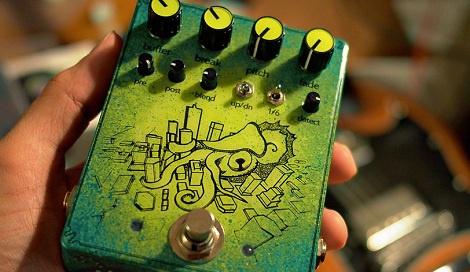
Building guitar pedals has come a long way from hooking up a few transistors and building a simple boost circuit. [Cloudscapes] has been working on a Anti-nautilus auto glitch, auto repeat pedal, and if you’re looking for something that sounds like a spaghetti western soundtrack skipping on a record player, we couldn’t think of anything better.
[Cloudscapes] was already familiar with 8-bit AVRs, but when doing real-time audio sampling, a more powerful microcontroller was in order. He turned to the MikroElektronika MINI-32 board for development purposes. This small board fits a PIC32 microcontroller into an easily breadboardable DIP-40 form factor, perfect for playing around with some very capable hardware.
For the DAC, [Cloudscapes] had some experience with the 16-bit PT8211, but finding a good 16-bit ADC in a convenient package was a bit of a challenge. He eventually settled on the 12-bit MCP3201 ADC, more than enough for a pedal that is supposed to sound lo-fi.
After [Cloudscapes] got a few boards made, he started on his DSP adventure. Unfortunately, the initial code used unsigned 16-bit words to represent each sample, meaning every time the loop repeated it would start at 0 and produce a short pop in the speaker. After a week of debugging, [Cloudscapes] realized signed integers are a much better data format for storing audio data and got rid of the problems plaguing his project.
Now [Cloudscapes] has a wonderful DSP dev board, perfect for making new and strange guitar effects. After the break you can listen to a demo of what the Anti-nautilus pedal actually does, and we’ve got to say it sounds great.
Thanks [Chris] for sending this one in.
[youtube=http://www.youtube.com/watch?v=JdqwXGB0944&w=470]














lol… the test video made my cat meow!:)
Ah, the bastard’s got an OP-1! /jealous
hmm quite a lot of popping still though
there’s a similar stutter effect pedal, hexe revolver
pretty cool though
There are two kinds of popping. The popping talked-about in the post-mortem only occured at loop-points when I was fading the samples (which was almost never in the video). The other “popping” which is more of a crackle, is the micro slicing that occurs every time the pedal truncates ppieces of sound. At the moment it’s unavoidable. I’m no DSP ninja. Besides, I don’t think the crackling sounds bad. It makes the sound broken, which is kind of the point. The loop-point popping def had to go though, because it occured even when you weren’t slicing/breaking sound up, and just used it as a weird sampler.
this might be of interest http://line6.com/tcddk/
whoa, I’m on hackaday!
this thing was a learning exercise, first venture out of the world of 8bit. I didn’t get everything right, but I’m happy with the result!
The case is very well done.
The case looks super pro!
Thanks! I’ve built hundreds of pedals so I’ve had the time to hone case-finishing.
great work!
You put Negativland on a chip!! <3
Presumably they’d consider that fair use.
I think the nautilus lost something between the 3D rendering and the final product, maybe the ragged shell makes it harder to identify.
Personally I still find the final drawing too clean. I may stencil it out by hand to give it a less perfect look. To make it similar to the art on an older pedal of mine: http://farm8.staticflickr.com/7178/6773298954_d99b645f26_z.jpg
interesting – and def. a nice case there.
would prefer to hear a familiar tune played through it though even if it’s just smoke on the water or stairway to heaven…
Using MikroElectronika’s PIC32 board, why not also use their audio CODEC board as well (single-chip ADC/DAC 24-bit resolution)?
http://www.mikroe.com/add-on-boards/audio-voice/audio-codec-proto/
The CODEC chip is very similar to what’s used in the iPhone, and Microchip also has some example code that should work (if you want to use MPLABX instead of MikroE’s tools):
http://www.microchip.com/stellent/idcplg?IdcService=SS_GET_PAGE&nodeId=1406&dDocName=en554942
Mainly because I’m still a beginner and the frame-mode SPI and exotic clock stuff that involves codecs still make my head spin a bit. As for DACs and ADCs, I’d been using those for years so I had those up and running in minutes.
I did order that board however, and I’ll be trying it out. See if I can get it pass sound. I don’t expect that to be very quick though. When it comes to teaching and being tought, I’m very much a simple-words layperson, and codec datasheets (which I have studied) are anything but.
See my friend Nicolas Collins’ work for some pioneering in this field: http://www.nicolascollins.com/texts/TrombonePropelledElectronics.pdf and http://www.nicolascollins.com/texts/devilsmusichistory.pdf
You might want to check out my friend Nicolas Collins’ pioneering work in this field: http://www.nicolascollins.com/texts/devilsmusichistory.pdf and http://www.nicolascollins.com/texts/TrombonePropelledElectronics.pdf